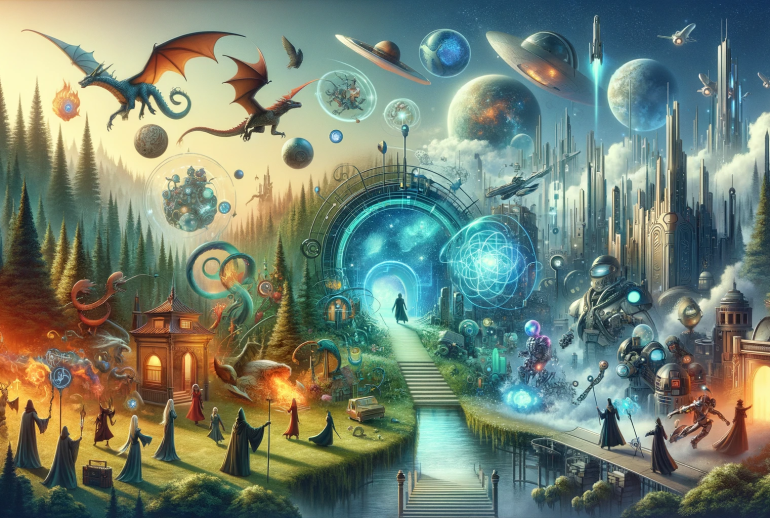World-building is an intricate craft where authors sculpt the landscapes of their imagination, crafting realms that readers can explore and lose themselves in. While words are the primary tools of the trade, visual aids such as maps and artwork play a crucial role in bringing fictional worlds to life. In this exploration, we delve into the art of visualizing your world, discovering how maps, artwork, and other visual aids can enrich your world-building process and captivate your readers.
The Power of Visual Aids
Maps: Charting the Unknown
Maps are powerful tools for both authors and readers. They provide a visual representation of your world’s geography, helping you maintain consistency and aiding readers in navigation. Here’s how to leverage maps effectively:
- Create Detailed Maps: Develop maps that encompass continents, regions, cities, and landmarks within your world. Be meticulous in your cartography to ensure geographical accuracy.
- Showcase Exploration: Use maps to depict uncharted territories, inspiring a sense of adventure in your readers. Include hidden places and mysterious locales to pique curiosity.
Artwork: Painting with Imagination
Artwork breathes life into your world, allowing readers to visualize landscapes, creatures, and characters. Commissioning or creating your artwork can be a transformative aspect of world-building:
- Character Portraits: Commission or create artwork that captures the essence of your characters. This visual reference helps readers connect with the individuals populating your world.
- Landscape Illustrations: Artwork depicting key locations or breathtaking vistas immerses readers in your world’s beauty and grandeur.
Case Study: J.R.R. Tolkien’s Middle-earth Maps and Artwork
J.R.R. Tolkien’s Middle-earth is renowned for its intricate maps and artwork. Tolkien himself was an accomplished artist and crafted detailed maps and illustrations that enriched his storytelling. These visual aids not only helped him maintain consistency but also allowed readers to embark on an immersive journey through Middle-earth.
Visualizing Cultures and Customs
Visual aids aren’t limited to maps and artwork; they can extend to cultural artifacts, symbols, and diagrams that enhance the understanding of your world’s customs and traditions:
- Symbolism: Create symbols and emblems representing different cultures or factions within your world. These symbols can convey deeper meaning and cultural identity.
- Diagrams: Use visual aids to explain complex societal structures, rituals, or technological innovations. Diagrams can provide clarity and deepen readers’ comprehension.
Incorporating Visual Aids in Your Narrative
Integrate Seamlessly: Embed visual aids within your narrative to enhance the storytelling experience. Describe maps, artwork, or symbols within the text to guide readers’ imaginations.
Supplementary Materials: Consider providing supplementary materials, such as an online gallery or downloadable maps, for readers who wish to explore your world visually. This can also serve as promotional content.
Reader Engagement Through Visuals
Visual aids have the power to engage readers on multiple levels:
- Immersion: Maps and artwork transport readers directly into your world, immersing them in its landscapes, cultures, and characters.
- Enhanced Comprehension: Visual aids clarify complex aspects of your world, making it easier for readers to grasp intricate details.
- Reader Interaction: Encourage readers to interact with your world by inviting them to explore maps or view artwork on your author website or social media.
Challenges and Considerations
While visual aids can enhance world-building, authors must navigate potential challenges:
- Consistency: Ensure that visual aids align with the narrative and adhere to the rules of your world.
- Budget: Commissioning artwork or creating detailed maps can be costly. Consider your budget and explore cost-effective options.
- Accessibility: Ensure that visual aids are accessible to all readers, including those with visual impairments. Provide alternative descriptions or tactile representations where possible.
Conclusion
Visualizing your world through maps, artwork, and visual aids is a transformative aspect of world-building. It allows readers to explore your imagination visually, enhancing their connection to your world and its inhabitants. When used effectively, visual aids breathe life into your world, enriching the storytelling experience and leaving readers with vivid and lasting impressions. As you embark on your world-building journey, remember that every stroke of the brush and every line on the map contribute to the magic of your literary realm, inviting readers to step inside and embark on a visual and literary adventure.



